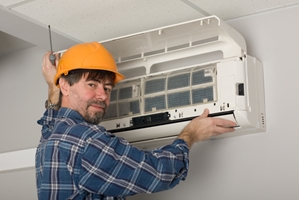Businesses are always looking for competitive advantages, whether they come in the form of new technology or services.
Sometimes, a point of difference arises from greater employee productivity. The question is, how does a company bolster worker performance? According to research, measuring and improving indoor air quality (IAQ) can go a long way in enhancing personnel output.
Legislative attention
Even governments have recognised poor IAQ’s effect on employee health. The Western Australia (WA) Department of Commerce acknowledged the issues associated with sick building syndrome (SBS) and building-related illness (BRI).
 Poor indoor air quality can lead to headaches and other problems.
Poor indoor air quality can lead to headaches and other problems.Those contending with SBS experience headaches, irritated eyes, noses or throats, dry coughs, itchy or dry skin and fatigue.
These symptoms may be more pronounced or less severe depending on how long people remain in an office with unsatisfactory IAQ.
BRI differs from SBS in that the signs associated with it are often more severe.
For instance, those with BRI not only experience headaches, but also encounter fevers, chills, muscle aches and chest tightness.
Obviously, any one of the aforementioned issues can negatively impact worker productivity.
Gas levels and performance
According to a study conducted by the University of Reading’s Dr Derek Clements-Croome, most buildings aim to keep carbon dioxide (CO2) levels below 1,000 parts-per million (ppm). That’s an air concentration of 0.1 per cent.
Decreasing CO2 in classrooms improved academic performance among students.
Dr Clements-Croome noted that when CO2 concentrations in a closed space reach 7.5 per cent, people within that area may experience restlessness, dizziness, increased blood pressure and other issues. Obviously, this negatively impacts worker well-being. As Dr Clements-Croome points out, a 10 per cent rise in dissatisfaction lowers performance by 1 per cent.
The World Green Building Council (WGBC) referenced a study on academic performance and CO2 levels. The research found that decreasing the amount of CO2 in classrooms generated a 3 per cent overall improvement in nine cognitive tests. In addition, the study found that CO2 levels of 1,500 ppm increased fatigue and tiredness among students.
An intelligent investment
In light of these studies, knowing which CO2 levels are ideal for indoor areas can go a long way in boosting employee performance. Using IAQ measurement instruments to calculate CO2 concentrations is the first step in determining whether employers need to make adjustments to ventilation systems.
There are other ways to improve IAQ as well. For instance, placing indoor plants around the office may reduce CO2 levels. Adding greenery also brings a little life to a conventional working area, satisfying people’s need to be around vegetation.









 Reduce cooking oil costs while ensuring quality
Reduce cooking oil costs while ensuring quality Expert knowledge on CO2 monitoring
Expert knowledge on CO2 monitoring Refrigeration knowledge - in 3 modules
Refrigeration knowledge - in 3 modules



